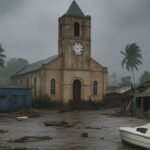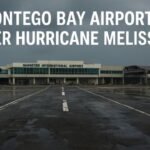When the Jamaica storm Hurricane Melissa slammed into the island this week, it wasn’t just another name in the Atlantic hurricane list. It became the strongest storm ever recorded to make landfall on Jamaican soil. With sustained winds clocking in at 185 mph, relentless flooding, and devastating storm surge on the southern coast, this wasn’t a routine weather event. This was the kind of storm that shifts memories, wrecks history, and rewrites how a nation prepares for what’s next.
At CycloneRadar, we’ve been tracking the path of Hurricane Melissa closely. What started as a powerful cyclone in the Caribbean Sea turned into a full-blown monster as it approached Jamaica. Fueled by warm sea temperatures and low wind shear, the storm went through rapid intensification, gaining strength alarmingly fast. Within hours, it surged to Category 5 status, putting meteorologists, emergency planners, and local residents on high alert. The phrase “Jamaica storm Hurricane Melissa” quickly became the center of conversation, across every newsroom and household in the region.
How it hit and why it was so bad
Melissa made landfall near New Hope in Westmoreland Parish, crawling at a sluggish 2 to 4 mph. That slow speed made everything worse. The core of the storm didn’t just sweep across the island, it dragged its eyewall across multiple parishes, grinding against hills, coastlines, homes, and lives for hours. The southern coast, especially places like St. Elizabeth and Clarendon, bore the full brunt of the surge. In some communities, walls of water over 10 feet tall pushed inland, swallowing roads and homes in minutes.
Rainfall totals were just as brutal. The Jamaica storm Hurricane Melissa dumped between 12 to 24 inches across the island, with some mountain areas seeing close to 30 inches. That kind of rain, especially over steep hills and already saturated soil, was a recipe for flash flooding and dangerous landslides. Entire villages were cut off, roads turned into rivers, and rescue operations had to be paused due to the sheer danger of navigating the terrain.
Wind damage was widespread. Roofs were peeled off like banana skins, utility poles snapped in domino lines, and even hospitals suffered structural damage. At one point, nearly the entire island experienced power outages. Communication towers fell, trees blocked highways, and the clean-up hasn’t even properly begun yet.
What made the Jamaica storm Hurricane Melissa even more terrifying is that it wasn’t a surprise. Officials had warned of its potential for days. The Office of Disaster Preparedness and Emergency Management (ODPEM) activated emergency protocols early, urging evacuations from flood-prone zones, releasing lists of high-risk areas, and coordinating shelters for those in danger. But even with all the preparation, the scale of impact was beyond anything most Jamaicans had ever seen.
Aftermath and what lies ahead
As of now, several deaths have been confirmed, with thousands displaced. The official numbers are still coming in, but what’s already clear is that the island has entered a new phase of recovery. Shelters remain open, roads are being cleared, and aid agencies like the Red Cross are distributing food, water, and medical supplies. Hospitals are working overtime, dealing with both injuries and the effects of interrupted services.
While Hurricane Melissa has since moved past Jamaica and is now threatening parts of eastern Cuba and the Bahamas, the storm’s effects in Jamaica will linger for weeks, if not months. Floodwaters are slow to recede. Power restoration is happening in phases. Landslides remain a serious risk, especially with rain continuing in the forecast.
The emotional toll is also rising. Thousands of families have lost everything. Homes. Schools. Farms. Businesses. The silence after the winds died down has been filled by the sounds of chainsaws, helicopters, emergency radios, and the slow grind of clean-up trucks rolling into neighborhoods that, just days ago, were thriving.
This storm will likely be remembered as Jamaica’s version of Katrina or Maria. A storm that reshapes policy, hardens building codes, and forces a national conversation about resilience. The phrase “Jamaica storm Hurricane Melissa” isn’t just a weather headline. It now lives in the collective memory of a nation, a warning and a lesson written in wind, water, and heartbreak.
Hurricane Melissa has exposed both the strengths and the vulnerabilities of Jamaica’s preparedness systems. The government acted early, agencies worked together, shelters were opened, and public warnings were loud and clear. But a storm of this magnitude tests every line of defense. What happens next matters even more than the storm itself. It’s about recovery. Rebuilding. Making things stronger. Listening to the science. Supporting each other.
For now, the island is picking up the pieces. Volunteers are showing up. Relief is arriving. Families are coming together. The resilience of the Jamaican people has always been powerful. But now, after Hurricane Melissa, that resilience will become the foundation for what comes next.


